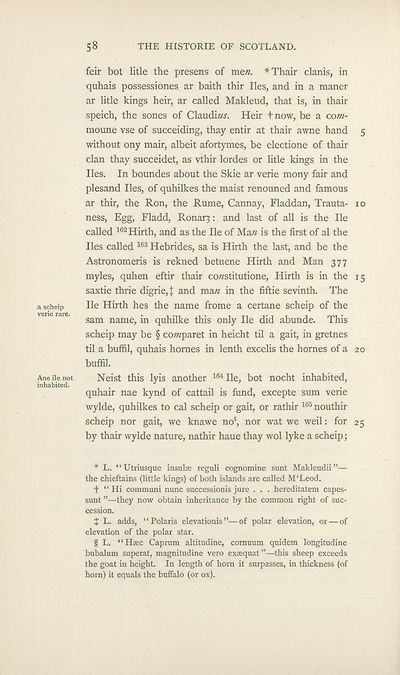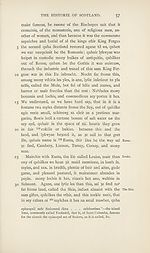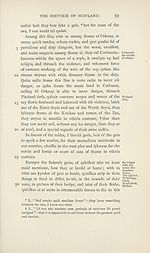Scottish Text Society publications > Old series > Historie of Scotland > Volume 1, 1888
(88) Page 58
Download files
Complete book:
Individual page:
Thumbnail gallery: Grid view | List view

58
THE HISTORIE OF SCOTLAND.
a scheip
verie rare.
Ane ile not
inhabited.
feir bot litle the presens of me«. *Thair clanis, in
quhais possessiones ar baith thir lies, and in a maner
ar litle kings heir, ar called Makleud, that is, in thair
speich, the sones of Claudi?«. Heir tnow, be a com-
moune vse of succeiding, thay entir at thair awne hand 5
without ony mair, albeit afortymes, be electione of thair
clan thay succeidet, as vthir lordes or litle kings in the
lies. In boundes about the Skie ar verie mony fair and
plesand lies, of quhilkes the maist renouned and famous
ar thir, the Ron, the Rume, Cannay, Fladdan, Trauta- 10
ness, Egg, Fladd, Ronar}: and last of all is the lie
called 162Hirth, and as the Ile of Ma« is the first of al the
lies called 163 Hebrides, sa is Hirth the last, and be the
Astronomeris is rekned betuene Hirth and Man 377
myles, quhen eftir thair co;zstitutione, Hirth is in the 15
saxtie thrie digrie,| and ma« in the fiftie sevinth. The
Ile Hirth hes the name frome a certane scheip of the
sam name, in quhilke this only Ile did abunde. This
scheip may be § cowparet in heicht til a gait, in gretnes
til a buffil, quhais homes in lenth excelis the homes of a 20
buffil.
Neist this lyis another 164 lie, bot nocht inhabited,
quhair nae kynd of cattail is fund, excepte sum verie
wylde, quhilkes to cal scheip or gait, or rathir 165 nouthir
scheip nor gait, we knawe no1, nor wat we weil: for 25
by thair wylde nature, nathir haue thay wol lyke a scheip;
* L. “ Utriusque instil* reguli cognomine sunt Makleudii ”—
the chieftains (little kings) of both islands are called M'Leod.
t “Hi communi nunc successionis jure . . . hereditateni capes-
sunt ”—they now obtain inheritance by the common right of suc¬
cession.
X L. adds, “Polaris elevationis”—of polar elevation, or — of
elevation of the polar star.
§ L. “ Hffic Cap rum altitudine, comuum quidem longitudine
bubalum superat, magnitudine vero exaequat ”—this sheep exceeds
the goat in height. In length of horn it surpasses, in thickness (of
horn) it equals the buffalo (or ox).
THE HISTORIE OF SCOTLAND.
a scheip
verie rare.
Ane ile not
inhabited.
feir bot litle the presens of me«. *Thair clanis, in
quhais possessiones ar baith thir lies, and in a maner
ar litle kings heir, ar called Makleud, that is, in thair
speich, the sones of Claudi?«. Heir tnow, be a com-
moune vse of succeiding, thay entir at thair awne hand 5
without ony mair, albeit afortymes, be electione of thair
clan thay succeidet, as vthir lordes or litle kings in the
lies. In boundes about the Skie ar verie mony fair and
plesand lies, of quhilkes the maist renouned and famous
ar thir, the Ron, the Rume, Cannay, Fladdan, Trauta- 10
ness, Egg, Fladd, Ronar}: and last of all is the lie
called 162Hirth, and as the Ile of Ma« is the first of al the
lies called 163 Hebrides, sa is Hirth the last, and be the
Astronomeris is rekned betuene Hirth and Man 377
myles, quhen eftir thair co;zstitutione, Hirth is in the 15
saxtie thrie digrie,| and ma« in the fiftie sevinth. The
Ile Hirth hes the name frome a certane scheip of the
sam name, in quhilke this only Ile did abunde. This
scheip may be § cowparet in heicht til a gait, in gretnes
til a buffil, quhais homes in lenth excelis the homes of a 20
buffil.
Neist this lyis another 164 lie, bot nocht inhabited,
quhair nae kynd of cattail is fund, excepte sum verie
wylde, quhilkes to cal scheip or gait, or rathir 165 nouthir
scheip nor gait, we knawe no1, nor wat we weil: for 25
by thair wylde nature, nathir haue thay wol lyke a scheip;
* L. “ Utriusque instil* reguli cognomine sunt Makleudii ”—
the chieftains (little kings) of both islands are called M'Leod.
t “Hi communi nunc successionis jure . . . hereditateni capes-
sunt ”—they now obtain inheritance by the common right of suc¬
cession.
X L. adds, “Polaris elevationis”—of polar elevation, or — of
elevation of the polar star.
§ L. “ Hffic Cap rum altitudine, comuum quidem longitudine
bubalum superat, magnitudine vero exaequat ”—this sheep exceeds
the goat in height. In length of horn it surpasses, in thickness (of
horn) it equals the buffalo (or ox).
Set display mode to: Large image | Zoom image | Transcription
Images and transcriptions on this page, including medium image downloads, may be used under the Creative Commons Attribution 4.0 International Licence unless otherwise stated. ![]()
| Publications by Scottish clubs > Scottish Text Society publications > Old series > Historie of Scotland > Volume 1, 1888 > (88) Page 58 |
|---|
| Permanent URL | https://digital.nls.uk/107369888 |
|---|
| Attribution and copyright: |
|
|---|
| Description | A collection of over 100 Scottish texts dating from around 1400 to 1700. Most titles are in Scots, and include editions of poetry, drama, and prose by major Scottish writers such as John Barbour, William Dunbar, Gavin Douglas, and George Buchanan. Edited by a key scholarly publisher of Scotland's literary history, and published from the late 19th century onwards by the Scottish Text Society. Available here are STS series 1-3. |
|---|

